Author: Clare Schofield, Greater Lincolnshire Nature Partnership
Reedbed habitat declines and its legal status
In England there are approximately 5200ha of reedbed; habitat dominated by stands of common reed Phragmites australis, where the water table is at or above ground level for most of the year. Many of these are small and isolated sites and only around 50 sites are greater than 20ha in extent. Reedbed is a UK Biodiversity Action Plan (BAP) priority habitat. The most significant reedbed areas are notified as Sites of Special Scientific Interest (SSSI) and many are also notified under the Ramsar Convention and as Special Protection Areas (SPA). However, in the wider countryside many reedbeds remain in poor condition for key species and in some cases they may be deteriorating due to a lack of appropriate management, sea-level rise due to climate change and pollution of fresh water supplies [i]. In Greater Lincolnshire, an area that includes Lincolnshire county, North Lincolnshire and North East Lincolnshire, reedbed is covered by the Lincolnshire BAP 3rd edition grouped Action Plan for reedbeds and Bitterns [i].
The map shows the known reedbed in Greater Lincolnshire with a 1km buffer for clarity. The estimated reedbed resource in Greater Lincolnshire is around 100ha. Most areas of reedbed are small and fragmented, however more extensive areas occur along the Humber Bank, from Barton to New Holland.
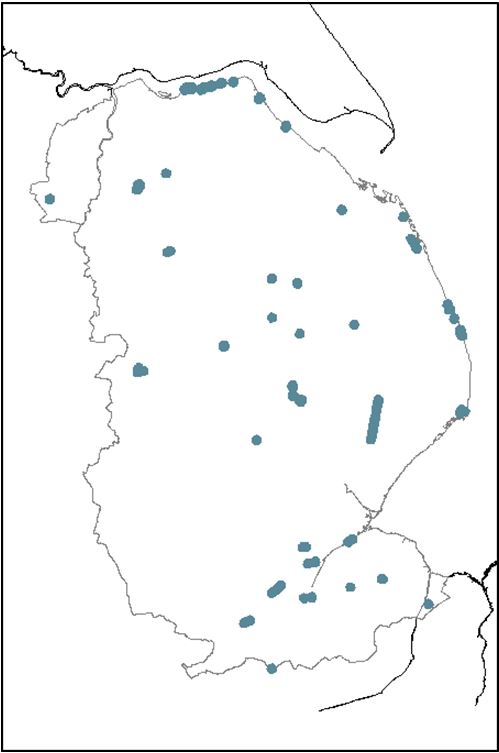
Bittern Botaurus stellaris population declines and their legal status
Bitterns are a localised and rare breeding species in the UK. It is confined almost entirely to reedbed habitats, where it feeds principally on fish and amphibians. The UK population had declined to just 11 booming males at seven sites in 1997 from a peak of 70-80 in the 1950s. Intensive study showed that in most cases the decline was due to deterioration in habitat. In recent years, increasing numbers of wintering bittern have been recorded at many sites in the UK, most of which do not currently support booming males (Wotton et al, 2011) [ii].
Wetland creation and restoration for bittern began in the mid-1990s, and the decline has now been halted and reversed. During the 2009/10 winter a minimum of 598 bittern were recorded at 396 sites across the UK, and in the 2012 breeding season, the number of booming males was up to 106.
Present threats to Bitterns include loss of suitable large reedbeds, reduced food availability, salt water intrusion into reedbeds, unseasonal fresh water flooding, severe winter weather and a small population size.
Due to the historic decline, its current breeding and non-breeding rarity and status as a Species of European Conservation Concern the Bittern is fully protected at all times in the UK under Schedule 1 of the Wildlife and Countryside Act 1981 (as amended) [iii] This prohibits the intentional killing, injuring or taking (including capture) of any wild bird, taking, damaging or destroying the nest while in use or being built, and the taking or destruction of any eggs. Bittern is listed on Annex 1 of the Birds Directive and Appendix III of the Bern Convention. It is a Red List species, a UK BAP priority species and is covered by the Lincolnshire BAP 3rd edition grouped Action Plan for reedbeds and Bittern.
Bittern habitat requirements
The common elements to the results of some of the most recent research on the breeding habitat preferences of Bittern in the UK [iv] are the presence of tall emergent vegetation and standing water, and in many cases, open water.
Although Bitterns will breed in reedbeds of a wide range of sizes (3-380ha in the UK), new reedbeds should ideally be as large as possible (c.100ha if possible) to accommodate habitat variation, especially in areas without smaller satellite reedbeds nearby. Bittern home ranges (studied on sites >100ha) are around 20ha on average, increasing in the non-breeding season.
With regard to reedbed structure, the most important parameter providing feeding habitat is the area of wet reed (growing in water) within 30m of pools. Ditches connected to pools can increase the suitability of a site, however, reed edge adjacent to open pools was preferred over that adjacent to channels and ditches. The reed/water interface is critical, with 250-400m of reed edge per hectare being the ideal target. Home ranges of the males have been found to be, on average, composed of 30% open water (excluding ditches), 48% reed edge (30m width adjacent to open water and ditches) and 16% reed that was 30m or more from any water edge.
When choosing a nest location, female Bitterns tend to have less scrub nearby and more reed/pool edge, avoiding vegetation indicative of dryness. Water levels around the nest are generally high even at the driest part of the season. Research in the 1990s suggested that breeding bittern in the UK use reedbeds with water depths between 15 and 30cm within the reed, however, new nests have been found at sites in Norfolk and Somerset in water up to 100cm deep (Wotton, pers. com). When seasonal water level changes occur, Bitterns will move to maintain ideal feeding depths. They will also move outside key reedbed areas to other feeding sites. Therefore maintaining variation in topography will maximise opportunities for bittern throughout the year.
As a piscivorous bird, access to fish populations is important for the bittern and reedbed design must provide conditions suitable for sustainable populations of principally fish, but also amphibians, crayfish, mammals and birds, which they will take from within extensive wet reed/open water interface. Female bitterns may be using the availability of the four fish species of preference in nestling diet (European eel Anguilla anguilla (which, according to the Environment Agency [v] has suffered a catastrophic decline across Europe with numbers estimated to have fallen to less than 5% of their 1980 levels), Rudd Scardinius erythrophthalmus, Three-spined stickleback Gasterosteus aculeatus and Nine-spined stickleback Pungitius pungitius) as one of their cues whether to settle at a site and nest (Gilbert and Jose 2003 [vi].
Wintering sites are crucial to the survival of individual birds which remain in or migrate to Greater Lincolnshire to avoid harsh winter weather however their requirements are less exacting than during the breeding season. Small wetland sites, not suitable for breeding, may be occupied if they have a good food supply and at least some cover in the form of wetland vegetation. Management of small sites for wintering birds should therefore be seen as important for the retention of Greater Lincolnshire’s Bittern population, even if breeding is unlikely [vii]
Reedbed and bittern conservation and research in Greater Lincolnshire: Lincolnshire Biodiversity Action Plan
The Lincolnshire Biodiversity Action Plan (BAP) describes the species and habitats that are priorities for conservation in Greater Lincolnshire and identifies actions that can take place at a local level which also contribute to national and international conservation commitments. The BAP includes a Species Action Plan (SAP) for Bittern.
The SAP for Bittern outlines a number of objectives and targets and the actions to be undertaken in order to achieve them:
Objectives
- To create a county-wide network of well-managed reedbeds and associated habitats capable of supporting key species
- To establish areas in Lincolnshire, particularly inland, that provide suitable habitat for breeding bitterns, to allow an expansion in range and provide a safeguard against sea-level rise
Targets
- Update the 2010 baseline for reedbeds by 2012 with details of condition, including extent of inland areas suitable for restoration or creation of breeding habitat for bittern
- Achieve favourable conservation management by 2015 for 95% of SSSIs and LWSs with reedbeds, and for sites newly created for bittern
- Increase the total area of reedbeds in Lincolnshire compared to 2010 figures – additional 500ha by 2020
- 50% of suitable sites with booming males or wintering birds by 2015
- Increase the breeding Bittern population in Lincolnshire to at least five sites with breeding females, three of them inland, by 2020
Actions
- Use existing information (and carry out further surveys as necessary) to determine the condition of identified sites
- Identify priority sites for habitat creation and expansion (especially for the benefit of Bitterns)
- Encourage the construction of reedbeds as a means of water treatment, including community and public facility use
- Produce assessments of the suitability and management for bitterns of occupied and unoccupied sites to identify the main features of each site and the principal actions required to improve or maintain them
- Monitor reedbed habitats, water quality and food availability at key Bittern sites
- Ensure management for Bittern within designated reedbeds where appropriate
- Survey all suitable reedbed sites annually for bittern activity. Ensure accurate recording of the presence of all breeding and wintering individuals throughout the county
- Ensure that any Bittern corpses or addled eggs are analysed for presence of heavy metals and pesticides
Getting involved:
Bittern monitoring
In order to be able to better protect bittern and their reedbed habitats and prevent further declines, it is important to have an accurate picture of the amount of suitable reedbed habitat and the species’ range and population status.
Surveying and monitoring are essential activities as they provide the basis for judging conservation decisions and the effectiveness of resulting actions. Having a believable baseline count or estimate for such an elusive species as the Bittern can provide the justification necessary to prioritise valuable resources, attract funding and set targets. As the habitat management necessary to restore or create sites for Bittern can be very expensive it is necessary to be able to measure how the population reacts to such expenditure.
The Royal Society for the Protection of Birds (RSPB) and Natural England have been responsible, through the Action for Birds in England program, for monitoring bittern in the UK annually since 1990. At the same time, an intensive research program focused on understanding the detailed habitat requirements of bittern, as well as habitat condition and food availability at key sites. The research program ended in 2004, but the monitoring program continued, annually until 2012 and a regular resurvey is planned for every few years from now on [viii]. Detailed Bittern monitoring methods are available from the Senior Conservation Scientist at the RSPB [ix].
As well as Bittern monitoring, it is important to also be aware of other biological parameters upon which habitat suitability will depend, including;
- Fish species and biomass
- Chemical water quality, water level and turbidity
- Reed cover
The records used to produce this report originated from a large number of sources including the Lincolnshire Bird Club [x] (LBC), Lincolnshire Wildlife Trust (LWT) reserve managers, national surveys, members of the public and other records held by Lincolnshire Environmental Records Centre (LERC) [xi] It has been collated by LERC, whilst maintaining confidentiality of the individuals that submitted it, and plays a vital role in informing conservation efforts, habitat management work and decisions about planning applications.
Sending in records
If you are involved with the Bittern monitoring programme, run by the RSPB in partnership with Natural England, please hand in all of the sheets, forms and maps that you filled in to your local co-ordinator or Bittern Project staff at the end of the season. The information will then be passed on to the LERC and included in national datasets in due course.
Please send all other information on Bittern sightings, booming activity or location of suspected nests to LBC or LERC. Other species records can also be sent to LERC.
For any record it is important to include as much information as possible – in particular:
- ‘What’ – the species (and number if more than one)
- ‘When’ – the date the Bittern was seen
- ‘Where’ – the location of the sighting (a grid reference or postcode is best)
- ‘Who’ – contact details in case any further details are needed
Using this report
The maps and species accounts in Section 3 summarise the information that is currently available on the distribution and status of bittern in Greater Lincolnshire. This report is intended to inform and support bittern conservation and awareness-raising work undertaken by BAP Partners.
It can also be used by conservation organisations, land managers, ecologists, planners and other interested parties to:
- Highlight key areas of the county that are of importance for Bittern.
- Identify areas where further surveys are needed.
- Indicate areas where particular consideration of the presence of bittern needs to be taken into account at sites of proposed development or habitat management works (though this should be taken into account in all areas of suitable habitat).
- Identify areas where habitat enhancement works could be targeted to benefit breeding or overwintering Bittern.
NOTE: The absence of a record does not necessarily mean that bittern are not present – simply that they have not been recorded.
Species account
The maps below have been produced using the bittern records and habitat data held by LBC and LERC, and show one page each for all bittern records, booming records (a booming male does not necessarily suggest breeding), summer records (April-July, no evidence of an attempt to breed) and wintering records (August-March). Each map shows the area of Greater Lincolnshire. Each 10km square, containing records of Bittern, is highlighted blue. Records have been divided into three date ranges: pre 1990, 1991-2000 and 2001-2011, to allow for comparison. Each map is accompanied by an interpretation of trends and possible explanations, information about known breeding sites, and identification of gaps in survey effort/knowledge. LBC and LERC would be pleased to hear from anyone that can add any further information or additional records (historic or recent) to the maps.
(1) All Bittern records
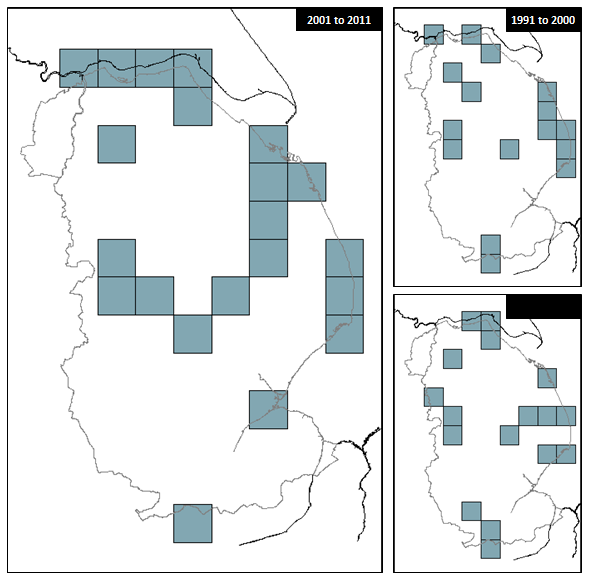
Fluctuation of the Bittern population in Greater Lincolnshire can be linked to: levels of reedbed management, with lack of management resulting in succession from reedbed to woodland with natural drying out of potential sites; reduction of water quality resulting in reduced prey items; and excessive water extraction (a potential issue if climate change requires more water to be used for farming practices). Some of these reasons may help to explain why sites where bittern have historically been recorded do not appear to have been used in recent years. The opposite also applies, as some of the more recent records are from within managed nature reserves where specific bittern habitat management does occur. Due to the specific habitat requirements of bitterns, perceived gaps in distribution indicate areas where no suitable habitat occurs, rather than a lack of surveyor effort, which has been sustained by the LBC for many years.
(2) Records of booming Bitterns
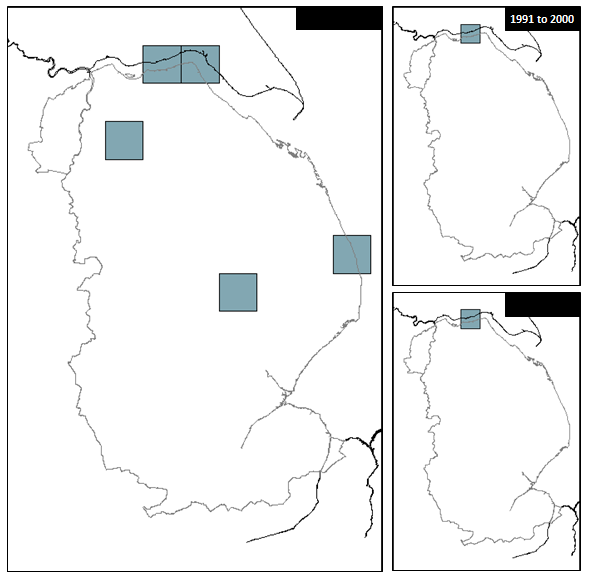
During the period 2001-11 Bittern were recorded as booming at a total of eight sites within Greater Lincolnshire. One of the sites has been used by booming Bittern repeatedly for the last 10 years. The examination of the current habitat management techniques of this site is necessary to identify best practice. Another site was used for seven years but not for the last few. The next stage will be to determine whether changes that may have occurred at that site have caused Bittern to stop using it, or whether another site was simply more favourable that year. Due to the specific habitat requirements of Bittern, perceived gaps in distribution indicate areas where no suitable habitat occurs, rather than a lack of surveyor effort, which has been sustained by the LBC for many years.
(3) Records of Bitterns seen from April to July
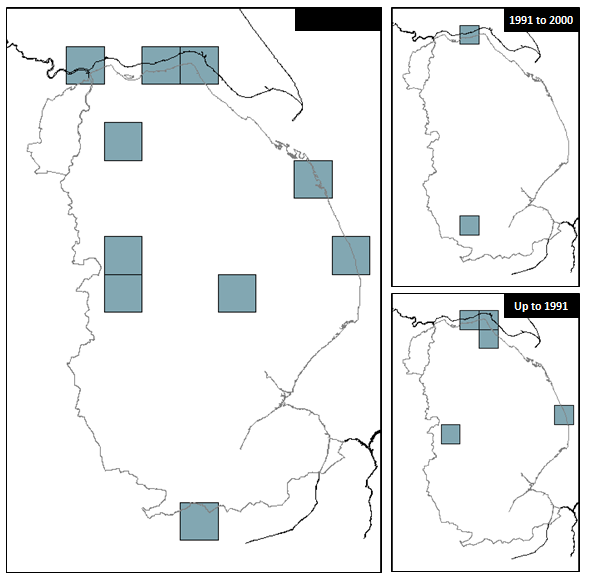
A high majority of the Greater Lincolnshire summer bittern records are within managed nature reserves where specific bittern habitat management occurs. Due to the specific habitat requirements of Bittern, perceived gaps in distribution indicate areas where no suitable habitat occurs, rather than a lack of surveyor effort, which has been sustained by the LBC for many years.
Sand and gravel extraction sites provide the main opportunities to create additional areas of reedbed in Greater Lincolnshire, with good opportunities for restoration of abandoned pits in the Isle of Axholme; at Messingham south of Scunthorpe; in the Trent Vale to the west and south-west of Lincoln; on the Fen edge at Tallington to Deeping Gate; and in the lower Bain valley at Kirkby and Tattershall. Other opportunities may arise through managed realignment schemes, Landscape Scale Project work, and work by Internal Drainage Boards.
(4) Records of Bitterns seen from August to March
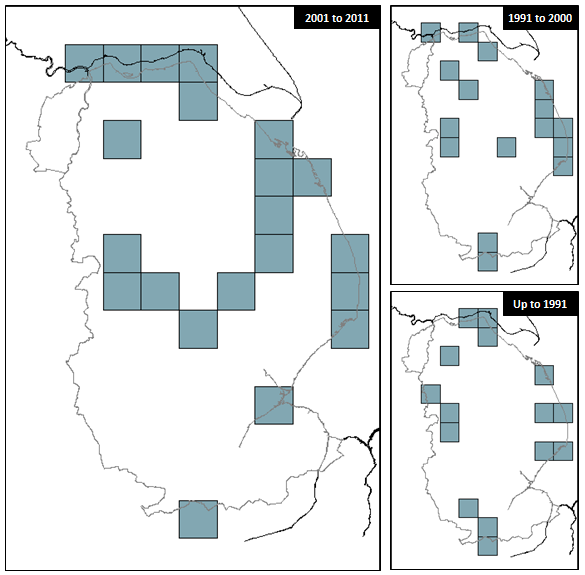
Between the winters of 2001/02 and 2011/12 a maximum of 12 sites had Bitterns recorded at them during any one year. A total of 38 sites have had Bittern recorded at least once during the above 10 winters. Many of the sites that have had bittern records submitted for them are in fact small ponds, which form part of a larger complex of sites that often falls within the boundary of a nature reserve.
The wintering population is heavily influenced by weather, both locally and on the continent, with bird numbers and sighting regularly reported by both LBC members and non-members. Due to the specific habitat requirements of bittern, perceived gaps in distribution indicate areas where no suitable habitat occurs, rather than a lack of surveyor effort, which has been sustained by the LBC for many years.
Conclusion
Greater Lincolnshire is fortunate to have Bitterns present, but only by a mixture of monitoring known sites and surveying new sites will we begin to establish the full distribution picture. By increasing our knowledge of Bittern ranges and protecting the habitat, we hope to protect bittern within Greater Lincolnshire. The small population of Bittern in Lincolnshire makes management for this species essential, with the chance of local loss of the resident population very high.
Size of site appears to be of little significance to bittern when choosing a breeding site while proximity of satellite sites may have a more important role. Many of the sites that have had bittern records submitted for them are in fact small ponds, which form part of a larger complex of sites which often falls within the boundary of a nature reserve. There is a lack of consistency however, and in many cases the record is assigned to the nature reserve rather than a specific pond making comparison difficult.
Implications
This report identifies the potential for Lincolnshire BAP actions to be fulfilled. It serves as a precursor to further survey and more detailed study of the condition of reedbed sites within Greater Lincolnshire. It is also intended to aid identification of those reedbeds where targeted management, restoration or creation would benefit breeding bittern and facilitate population expansion, especially as there have been no records of confirmed nesting in Greater Lincolnshire in recent years.
The contribution of individuals working or volunteering in the field is vital to the broadening of our knowledge and understanding of bittern and it is hoped that conservation organisations, ecologists, and other interested parties will feel encouraged by this report to carry out annual surveys, ideally following the methodology used by the RSPB, and realise the importance of submitting their records.
It would be valuable to have an assessment of food availability every five years or so at sites that have been used by bittern more than once within the last five years. This could include electrofishing surveys. If predatory fish such as Northern pike Esox lucius and European perch Perca fluviatilis are found to be a problem, they could be removed to benefit other species. Due to the decline in European eel Anguilla anguilla numbers the Eels (England and Wales) Regulations 2009 (the Regulations) [xii] require, among other things, the installation of eel passes and screens on abstraction points. To provide maximum benefit to bittern these need to be targeted on catchments with reedbed habitat. Actions to improve water quality and adjust hydrology may also be of benefit.
Simultaneously, the examination of the current habitat management techniques of successful bittern breeding sites is necessary to identify best practice. Detailed maps and site specific knowledge would determine the significance of the wet reed/open water interface which has not been assessed as part of this report.
Acknowledgements
The Greater Lincolnshire Nature Partnership is grateful to Andrew Chick (Lincolnshire Bird Club), Phil Espin (Lincolnshire Bird Club Rare Breeding Birds Panel Representative) and Simon Wotton (Royal Society for the Protection of Birds) for their contribution to ‘Reedbeds and bittern: An assessment of current status in Greater Lincolnshire’.
This report has been kindly funded by the Environment Agency.
[i] Lincolnshire BAP 3rd edition
[ii] Wotton, S., Grantham, M., Moran, N. and Gilbert, G. 2011. Eurasian bittern distribution and abundance in the UK during the 2009/10 winter. British Birds 104: 636-641.
[iii] www.legislation.gov.uk/ukpga/1981/69
[iv] Gilbert, G.; Tyler, G. A.; Dunn, C. J.; Smith, K. W. 2005. Nesting habitat selection by bitterns Botaurus stellaris in Britain and the implications for wetland management. Biological Conservation 124: 547-553.
[v] http://a0768b4a8a31e106d8b0-50dc802554eb38a24458b98ff72d550b.r19.cf3.rackcdn.com/geho0411btqb-e-e.pdf
[vi] Gilbert G. and P. Jose 2003. The status of Bittern Botaurus stellaris in relation to fish stocks. Proc. Inst. Fish. Manage. 32nd Ann. Stucy Course, Greenwich, London: 124-130
[vii] White G, Purps J and Alsbury S. (2006). The bittern in Europe: a guide to species and habitat management. The RSPB, Sandy
[viii] Royal Society for the Protection of Birds. www.rspb.org.uk/ourwork/projects/details/258718-annual-bittern-monitoring-
[ix] Simon Wotton, RSPB, The Lodge, Sandy, Bedfordshire SG19 2DL This email address is being protected from spambots. You need JavaScript enabled to view it.
[x] Lincolnshire Bird Club www.lincsbirdclub.co.uk/
[xi] LERC is a part of Greater Lincolnshire Nature Partnership www.glnp.org.uk
[xii] http://a0768b4a8a31e106d8b0-50dc802554eb38a24458b98ff72d550b.r19.cf3.rackcdn.com/geho0411btqb-e-e.pdf









